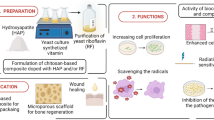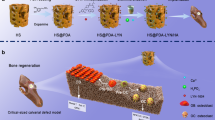Abstract
Safe and efficient gene delivery would have great potential in gene therapy and tissue engineering, but synthetic biomaterial surfaces endowed with efficient gene-transferring functions do not yet exist. Inspired by naturally occurring biomineralization processes, we co-precipitated DNA with inorganic minerals onto cell-culture surfaces. The DNA/mineral nanocomposite surfaces obtained not only supported cell growth but also provided high concentrations of DNA in the immediate microenvironment of the cultured cells. Gene transfer from the engineered surfaces was as efficient as an optimized commercial lipid transfection reagent; in addition, the extent of gene transfer was adjustable by varying the mineral composition. DNA/mineral nanocomposite surfaces represent a promising system for enhancing gene transfer and controlling the extent of gene transfer for various biomedical applications, including tissue engineering or gene therapy of bone.
This is a preview of subscription content, access via your institution
Access options
Subscribe to this journal
Receive 12 print issues and online access
$259.00 per year
only $21.58 per issue
Buy this article
- Purchase on Springer Link
- Instant access to full article PDF
Prices may be subject to local taxes which are calculated during checkout





Similar content being viewed by others
References
Tan, J. & Saltzman, W.M. Biomaterials with hierarchically defined micro- and nanoscale structure. Biomaterials 25, 3593–3601 (2004).
Matsumoto, T. et al. Biodegradation of carbonate apatite/collagen composite membrane and its controlled release of carbonate apatite. J. Biomed. Mater. Res. 60, 651–656 (2002).
Laurencin, C.T. et al. Poly(lactide-co-glycolide)/hydroxyapatite delivery of BMP-2-producing cells: a regional gene therapy approach to bone regeneration. Biomaterials 22, 1271–1277 (2001).
Barralet, J.E., Aldred, S., Wright, A.J. & Coombes, A.G. In vitro behavior of albumin-loaded carbonate hydroxyapatite gel. J. Biomed. Mater. Res. 60, 360–367 (2002).
Godbey, W.T., Wu, K.K. & Mikos, A.G. Poly(ethylenimine) and its role in gene delivery. J. Control. Release 60, 149–160 (1999).
Mao, H.Q. et al. Chitosan-DNA nanoparticles as gene carriers: synthesis, characterization and transfection efficiency. J. Control. Release 70, 399–421 (2001).
Segura, T. & Shea, L.D. Surface-tethered DNA complexes for enhanced gene delivery. Bioconj. Chem. 13, 621–629 (2002).
Bennett, M.J. et al. Cationic lipid-mediated gene delivery to murine lung: correlation of lipid hydration with in vivo transfection activity. J. Med. Chem. 40, 4069–4078 (1997).
Templeton, N.S. et al. Improved DNA: liposome complexes for increased systemic delivery and gene expression. Nature Biotechnol. 15, 647–652 (1997).
Uduehi, A.N., Moss, S.H., Nuttall, J. & Pouton, C.W. Cationic lipid-mediated transfection of differentiated Caco-2 cells: a filter culture model of gene delivery to a polarized epithelium. Pharm. Res. 16, 1805–1811 (1999).
Batard, P., Jordan, M. & Wurm, F. Transfer of high copy number plasmid into mammalian cells by calcium phosphate transfection. Gene 270, 61–68 (2001).
Roy, I., Mitra, S., Maitra, A. & Mozumdar, S. Calcium phosphate nanoparticles as novel non-viral vectors for targeted gene delivery. Int. J. Pharm. 250, 25–33 (2003).
Luo, D. & Saltzman, W.M. Synthetic DNA delivery systems. Nature Biotechnol. 18, 33–37 (2000).
Lowenstam, H.A. & Weiner, S. On Biomineralization (Oxford Univ. Press, New York, 1989).
Mann, S. & Ozin, G.A. Synthesis of inorganic materials with complex form. Nature 382, 313–318 (1996).
Ngankam, P.A. et al. Influence of polyelectrolyte multilayer films on calcium phosphate nucleation. J. Am. Chem. Soc. 122, 8998–9005 (2000).
Banyay, M., Sarkar, M. & Graslund, A. A library of IR bands of nucleic acids in solution. Biophys. Chem. 104, 477–488 (2003).
Corsi, K., Chellat, F., Yahia, L. & Fernandes, J.C. Mesenchymal stem cells, MG63 and HEK293 transfection using chitosan-DNA nanoparticles. Biomaterials 24, 1255–1264 (2003).
Shen, H., Goldberg, E. & Saltzman, W.M. Gene expression and mucosal immune responses after vaginal DNA immunization in mice using a controlled delivery matrix. J. Control. Release 86, 339–348 (2003).
Acknowledgements
We thank Mandy Ma for technical support. This work was supported by the National Institutes of Health (NIH grant number DE14097).
Author information
Authors and Affiliations
Corresponding author
Ethics declarations
Competing interests
The authors declare no competing financial interests.
Rights and permissions
About this article
Cite this article
Shen, H., Tan, J. & Saltzman, W. Surface-mediated gene transfer from nanocomposites of controlled texture. Nature Mater 3, 569–574 (2004). https://doi.org/10.1038/nmat1179
Received:
Accepted:
Published:
Issue Date:
DOI: https://doi.org/10.1038/nmat1179
This article is cited by
-
A Self-Biomineralized Novel Adenovirus Vectored COVID-19 Vaccine for Boosting Immunization of Mice
Virologica Sinica (2021)
-
Functionalization of microparticles with mineral coatings enhances non-viral transfection of primary human cells
Scientific Reports (2017)
-
Enhanced cryopreservation of MSCs in microfluidic bioreactor by regulated shear flow
Scientific Reports (2016)
-
Nanofiber-mediated release of retinoic acid and brain-derived neurotrophic factor for enhanced neuronal differentiation of neural progenitor cells
Drug Delivery and Translational Research (2015)
-
Inorganic coatings for optimized non-viral transfection of stem cells
Scientific Reports (2013)



